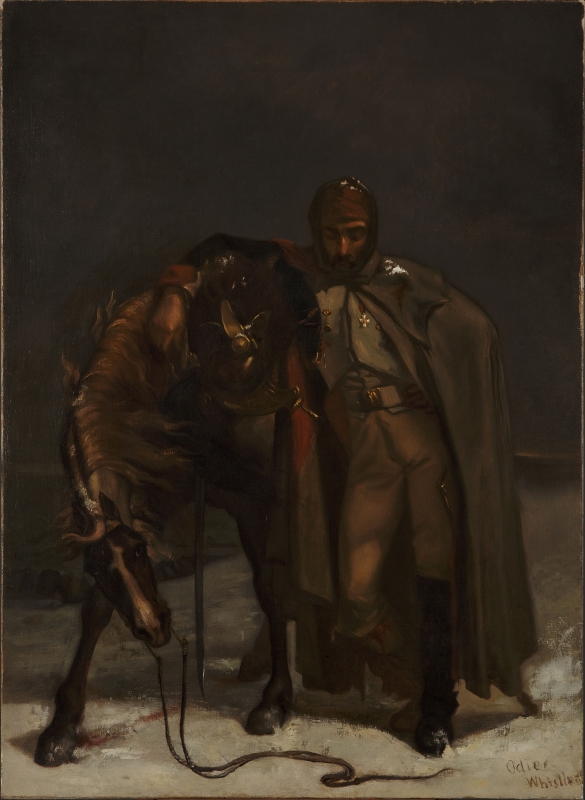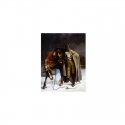Home > Catalogue > Browse > Copy after Odier's 'Episode de la retraite de Moscou' << >>
Composition
Whistler, in 1900, remembered it as 'a snow scene, with a horse and a soldier standing by it and another in the snow at his feet.' 1 .
The subject is taken from the Episode de la retraite de Moscou of 1832 (261 x 198 cm; Musée de Picardie, Amiens) by Edouard-Alexandre Odier (1800-1887), which was shown at the Salon of 1833 as 'Dragon de la garde impériale – étude', was awarded a second-class medal, and went on exhibition in the Musée du Luxembourg in the same year.
In 1833 Charles Paul Landon in his Annales du musée et de l'école moderne des beaux-arts: Salon, described Odier as 'amateur', his works either being the product of his imagination, or offering technical challenges. He described Dragon de la Garde impériale blessé as the latter, and as a study comparable to those of Théodore Géricault (1791-1824),
'M. Odier parâit avoir cherché à surmounter une difficulté, celle de détacher une figure vêtue d'un manteau blanc de dessus un fond de neige. Sa tentative n'a produit qu'un effet général triste et sans ressort. Mais nous devons des éloges à la figure du dragon, dont l'expression d'affaissement, de souffrance et de résignation, est rendue avec beaucoup de talent, et à l'exécution de plusieurs parties qui décèlent une habileté peu commune; seulement, le cheval sur lequel s'appuie le dragon nous semble avoir les jambes de devant trop écartées.' 2
This translates roughly as follows: 'M. Odier seems to have sought to overcome a difficulty, that of distinguishing a figure in a white coat from a background of snow. His attempt only produced a generally sad effect. But we owe praise to the figure of the dragoon, whose expression of weariness, suffering and resignation, is rendered with great talent, and to the execution of several parts that reveal an unusual skill; on the other hand, the horse on which the dragoon leans seems to have the front legs too far apart.'
A version attributed to (and said to be signed by) Odier, Cavalier sur la neige, canvas, 98 x 77 cm, was sold at auction by Aguttes, Neuilly-sur-Seine, 21 December 2011 (lot 31).
The subject seems to have been popular with American collectors. William Thompson Walters (1820-1894) claimed to have spent the first five dollars he earned in about 1847 to buy a copy of Odier's painting. 3
Technique
Whistler thought his copies for Captain Williams were 'wonderful things.' 4 This copy was painted carefully, with long, free brush strokes on areas like the clothes, and a small brush used to apply highlights on, for instance, the gilt buttons and medal. The mane of the horse was painted with drier, less liquid brush strokes.
Conservation History
Ultra-violet light revealed many small spots of repair, possibly replacing paint loss. There may have been some damage at the lower edge, where the snow is roughly painted and impasted. It may have been touched up by another hand. Likewise the inscription and signature may have been touched up or even replaced. It is surprising that the date is not included, and again, this implies the canvas could have been damaged at the lower right corner.
Frame
Nothing is known of the original frame, which was probably made in Connecticut in 1858.
Last updated: 18th April 2021 by Margaret








